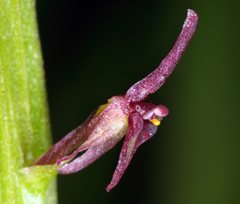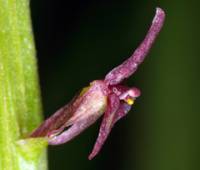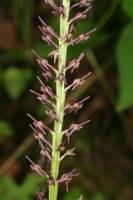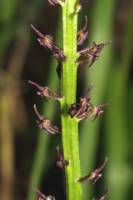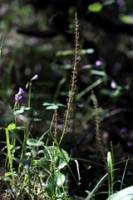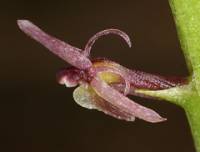Plants 16-45 cm. Pseudobulbs 5-10 mm diam. Leaves 1, within proximal 1/3 of stem; blade orbiculate-ovate or ovate-lanceolate, (3-)4.1-8.5(-10) × 0.2-0.45 (-0.65) cm, apex obtuse to acute. Inflorescences racemes, 6-25 cm; rachis slightly angled; floral bracts triangular to lanceolate, 1-2 × 0.5 mm, apex acute; pedicels not crowded, 2.5-5 mm. Flowers 16-133, resupinate, deep maroon or greenish maroon; sepals glabrous, not papillose; dorsal sepal lanceolate, 1.8-2.4 × 0.8-1.2 mm, margins revolute, apex acute; lateral sepals lanceolate-elliptic, falcate, 1.8-2.4 × 0.8-1.2 mm, apex acute; petals strongly recurved, linear to filiform, slightly falcate, 1.8-2.2 × 0.2-0.4 mm, apex obtuse; lip triangular to triangular-lanceolate, 1.8-2.3 × 1.3-1.8 mm, base with auricles narrow and nearly parallel, apex broadly acuminate; column 0.5-0.8 × 0.5-0.8 mm; pollinia yellow. Capsules ascending, ellipsoid, 5 × 3 mm.
Flowering Jul--Sep. Open coniferous and mixed forests on dry slopes; 2000 m; Ariz., N.Mex.; Mexico.
Both Malaxis porphyrea and M. wendtii have been included incorrectly in M. ehrenbergii (D. S. Correll 1950; C. A. Luer 1975). The confusion among the taxa is discussed by T. K. Todsen (1997). Malaxis ehrenbergii is a Mexican species with its northernmost limit in southern Hidalgo, about 1200 km to the south of the ranges of the other two taxa, the southernmost ranges of which are in northern Chihuahua and Sonora. The following criteria are used to separate M. wendtii from M. porphyrea: the sepals of M. wendtii are papillose while the sepals of M. porphyrea are essentially glabrous, although they have prominent cell structures that may appear to be very small papillae; the lip of M. wendtii is linear to linear-lanceolate with a narrowly acuminate apex, and the auricles at the base of the lip are broad and diverging, while the lip of M. porphyrea is nearly triangular to triangular-lanceolate with a broadly acuminate apex, and the auricles at the base of the lip are narrow and nearly parallel. Also, M. wendtii has a denser inflorescence and the flowers are not quite as intensely colored as in M. porphyrea (R. A. Coleman, W. Jennings, pers. comm.).
Duration: Perennial
Nativity: Native
Lifeform: Forb/Herb
General: Grows from swollen stem with few fibrous roots, 16-45 cm tall, with pseudobulbs 5-10 mm in diameter.
Leaves: Usually only one on the lower third of the stem, the blade orbiculate-ovate to ovate lanceolate, 4-8.5 cm long and 2-5 mm wide, the apex obtuse to acute.
Flowers: On a raceme 6-25 cm long, the bracts triangular to lanceolate, 1-2 mm long by 0.5 mm wide, the apex acute, bearing 16-100+ flowers, resupinate, purple to deep maroon, the flowers 5 mm long by 1.5 mm wide, glabrous sepals, 1.8-3 mm long, the petals wispy and purple, linear to filiform, same size as sepals, the apex obtuse and strongly recurved, folding back to cross behind ovary; triangular shaped purple lip, with whitish yellow triangular ridge in center, all these parts covered in tiny papillae, the column less than 1 mm high with two pairs of bright yellow pollinia.
Fruits: Very low rate of fruit set, often only one or two capsules per plant, these ascending 5 mm by 3 mm.
Ecology: Found in moist sites, often in colonies in mixed conifer forests from 6,500-9,500 ft (1981-2896 m), flowers July-September.
Distribution: Ranges across the mountains of Arizona and New Mexico, from the Mogollon Rim and White Mountains, to the Chiricahuas, Huachucas, and Santa Ritas, it dips into both Sonora and Chiricahua in areas with higher elevation forests.
Notes: Long confused with and thought to be M. ehrenbergii, this species is very rare and is distinguished by the vibrant purple flowers and the distance of several Mexican states along with its minutely papillate floral segments and a narrowly sagittate lip. The former has glabrous flora segments and broadly triangular-hastate lip. Often found in colonies and known to be very sensitive to disturbance. Likely candidate species in years to come, known populations undoubtedly threatened by the Horseshoe Two fire in 2011.
Ethnobotany: Unknown
Etymology: Malaxis is from the Greek word for soft or softening, a reference to the tender leaves, while porphyrea means reddish purple.
Synonyms: Microstylis purpurea, Microstylis porphyrea, Achroanthes purpurea, Achroanthes porphyrea
Editor: SBuckley 2011


